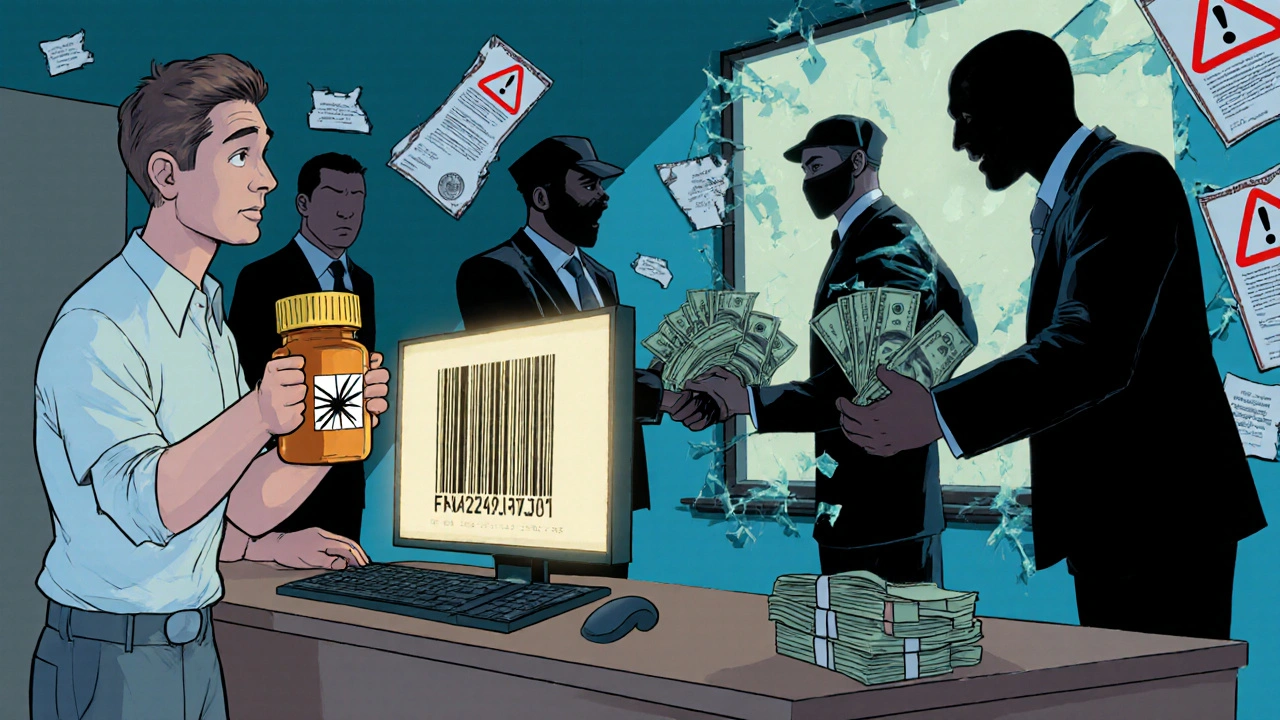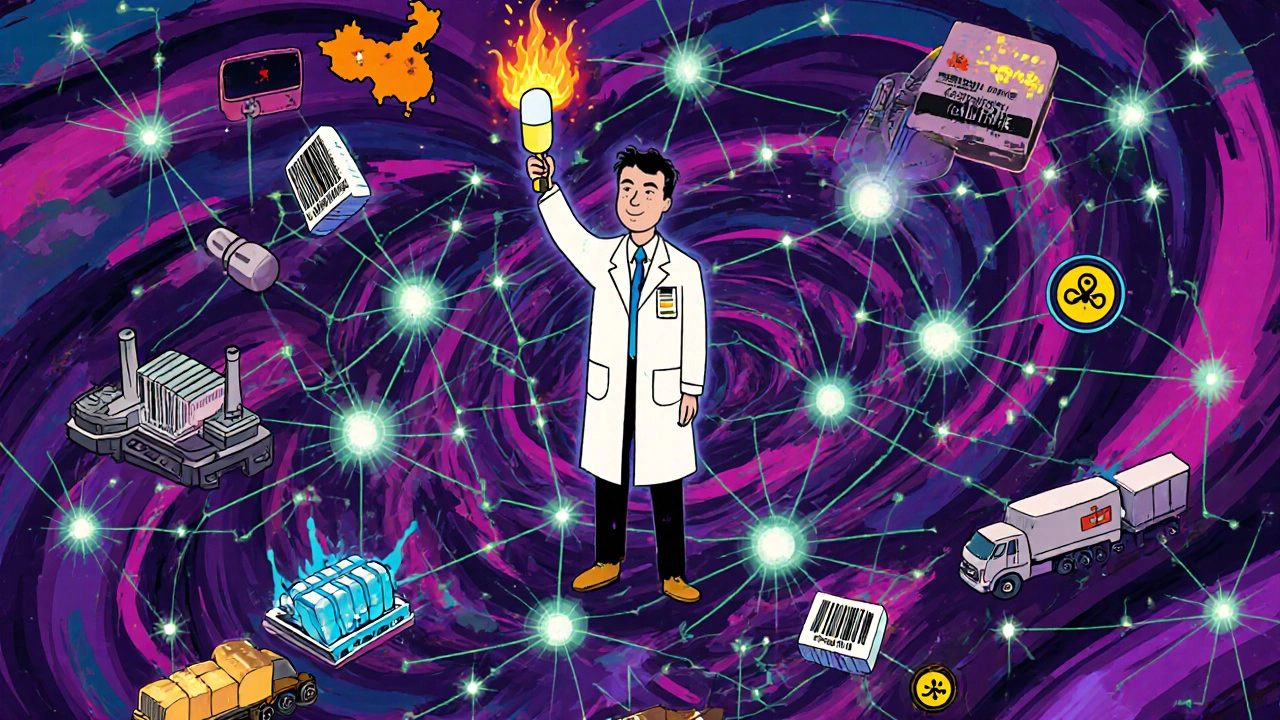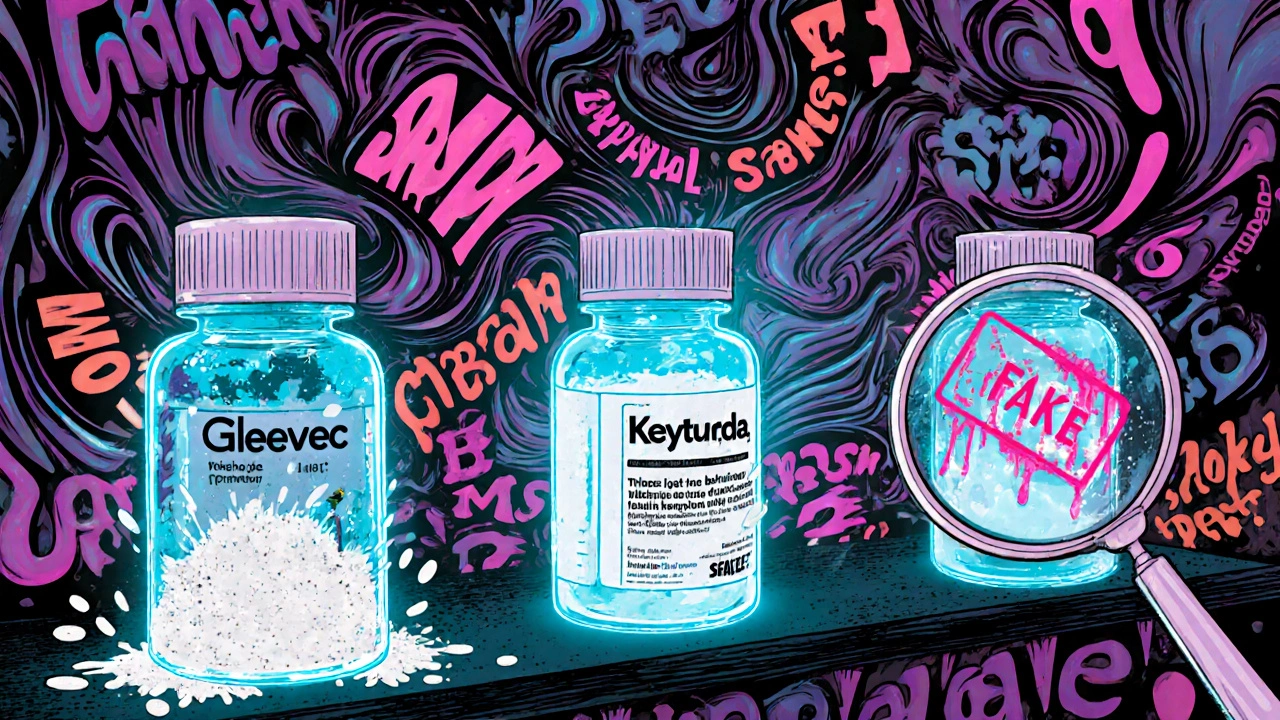Every year, millions of people around the world take pills they think are real medicine. But for some, those pills are fake. They might have no active ingredient at all. Or worse-they could contain poison, rat poison, or the wrong dose. And when something goes wrong, who pays? That’s where insurance comes in. But not all insurance policies are created equal when it comes to counterfeit drugs.
What Counts as a Counterfeit Drug?
A counterfeit drug isn’t just a knockoff. According to the World Health Organization, it’s any medical product that’s been deliberately mislabeled-about its identity, ingredients, or source. That means a bottle of fake Viagra with chalk instead of sildenafil is counterfeit. So is a vial of Avastin that’s been refilled with saline and sold as cancer treatment. It’s not about packaging. It’s about deception.
Counterfeit cancer drugs like Gleevec, Keytruda, and Abraxane are especially dangerous. Patients who think they’re getting life-saving treatment are actually getting nothing-or something harmful. The FDA has intercepted fake versions of these drugs coming in from overseas. Some are made in unregulated labs in China or India. Others are repackaged from stolen or expired stock. And because they look real, even pharmacies and distributors can be fooled.
Who’s at Risk-and Who Gets Covered?
If you’re a hospital, pharmacy, or distributor, you’re on the front line. You didn’t make the fake drug. You didn’t know it was fake. But if a patient gets sick or dies because of it, you could be sued. That’s where professional liability and product liability insurance come in.
Most insurers, like Beazley and other life sciences carriers, will cover you only if you acted in good faith. That means you followed standard procedures: you bought from approved suppliers, checked certificates of analysis, and didn’t cut corners to save money. But if you bought drugs from a shady online vendor because they were 70% cheaper? That’s not covered. Insurance doesn’t protect negligence.
One real case involved a small clinic in Texas that bought bevacizumab (Avastin) from a broker. The drug was fake. Three patients lost vision. The clinic’s insurer paid out over $2 million in settlements-but only after a long investigation proved the clinic had no reason to suspect fraud. The broker? Gone. Untraceable. No one to sue.
What Insurance Won’t Cover
Insurance isn’t a magic shield. It won’t cover you if:
- You knowingly bought from an unverified supplier
- You ignored red flags like missing batch numbers or odd packaging
- You didn’t run basic authenticity checks
- You’re the manufacturer who deliberately diluted or substituted ingredients
Insurers are smart. They look at your supply chain history. If you’ve had complaints before, or if your vendor list includes companies flagged by the FDA or Interpol, your premiums will jump-or your policy might get canceled.
Even if you’re covered, there’s a catch: insurance pays for legal defense and settlements. It doesn’t pay for lost revenue. If your brand gets tied to a counterfeit scandal-even if you’re innocent-patients may stop trusting you. That’s a loss no policy can fix.

How Regulations Are Changing the Game
In 2013, the U.S. passed the Drug Supply Chain and Security Act. By November 2023, every prescription drug had to have a unique identifier-like a digital barcode-that lets it be tracked from manufacturer to pharmacy. That’s huge. It means if a batch turns out to be fake, regulators can trace it back to the exact warehouse, truck, or distributor that handled it.
Insurers now use this data. If you’re using the electronic tracing system, you’re seen as lower risk. You’re not just buying drugs-you’re verifying them. That can mean lower premiums.
Other countries have rules too. The Medicrime Convention, which came into force in 2016, makes counterfeiting a criminal offense across 40+ countries. Fines can be steep. Jail time is possible. But enforcement? That’s still patchy. In some places, police don’t even test pills-they just shut down websites and call it a day.
How Companies Are Fighting Back
Big pharma isn’t waiting for regulators. Pfizer has stopped over 302 million fake doses since 2004. How? They have a global security team that uses lab equipment to analyze suspicious pills. They work with customs, police, and even online platforms like Amazon and Alibaba to take down fake listings.
Sanofi runs a 24/7 anti-counterfeit lab. Their team scans millions of webpages daily looking for their drugs being sold illegally. Bristol Myers Squibb claims a 93% success rate shutting down illegal sales sites. These aren’t just PR moves-they’re risk management.
And insurers notice. Companies that invest in these systems get better rates. Why? Because they’re reducing the chance of a claim. It’s simple: if you’re doing the work to stop fakes, you’re less likely to get sued.
What You Can Do Right Now
If you’re in the supply chain-whether you’re a small pharmacy, a distributor, or a clinic-here’s what to do:
- Only buy from suppliers on the FDA’s approved list or those with VIPPS certification
- Always ask for a Certificate of Analysis (CoA) and verify it with the manufacturer
- Check batch numbers against the manufacturer’s public database
- Look for tamper-evident packaging-seals, holograms, UV markings
- Train staff to spot fake packaging: misspellings, blurry logos, mismatched colors
- Keep digital records of every purchase and delivery
Don’t assume your insurance will save you. It won’t. It only kicks in if you’ve done your homework.

The Hidden Cost of Counterfeit Drugs
It’s not just about lawsuits. Counterfeit drugs hurt everyone.
Patients lose trust. People stop taking their meds because they’re scared. That leads to worse health outcomes. Studies show counterfeit drugs reduce adherence by up to 40% in some regions.
Pharmaceutical companies lose billions. Bristol Myers Squibb says the fake drug market is a $200 billion a year industry. That money doesn’t just vanish-it comes out of R&D budgets. Fewer new drugs get made because profits are eaten up by counterfeiting.
And consumers? They pay twice. Once for the fake drug. Again when they need real treatment because the fake didn’t work.
Why This Matters More Than Ever
The rise of online pharmacies makes this worse. A patient in rural Australia or rural Ohio can order pills from a website that looks legit-until it’s too late. No prescription? No problem. Cash on delivery? Easy.
Insurers are responding. Some now require proof of digital traceability before offering coverage. Others are adding clauses that exclude coverage if a company doesn’t use blockchain-based tracking or RFID tags on high-risk drugs.
It’s no longer enough to say, “I didn’t know.” You have to prove you tried to know.
Final Thought: Insurance Isn’t a Substitute for Vigilance
Insurance protects you after something goes wrong. But it doesn’t stop it from happening. The real safety net isn’t a policy-it’s a process. A system. A culture of checking, verifying, and questioning.
Counterfeit drugs are a global problem. But your part in stopping them? That’s local. It starts with one bottle. One order. One question: “Is this real?”
Does my business insurance cover me if I unknowingly sell counterfeit drugs?
Yes-but only if you can prove you acted in good faith. That means you bought from verified suppliers, checked documentation, and followed industry standards. If you ignored red flags or chose the cheapest vendor, your claim will likely be denied. Insurers look for due diligence, not just luck.
What’s the biggest mistake pharmacies make with counterfeit drugs?
Buying from non-approved distributors just to save money. A fake drug that costs $50 might save you $200 per bottle. But if a patient is harmed, your legal bills, fines, and reputation damage could cost millions. The savings aren’t worth the risk.
Can I rely on the FDA to catch all counterfeit drugs?
No. The FDA intercepts thousands of shipments each year, but the global supply chain is too vast to monitor every pill. Experts estimate less than 1% of counterfeit drugs are ever caught before reaching patients. Your responsibility is to verify what you receive-not wait for government intervention.
Are online pharmacies always illegal?
No. Legitimate online pharmacies are licensed and display a VIPPS seal from the National Association of Boards of Pharmacy. But many fake sites copy the seal. Always check the website’s URL, verify contact info, and confirm the pharmacy is physically located in your country. If it ships from overseas and doesn’t require a prescription, it’s risky.
What should I do if I suspect I’ve received counterfeit drugs?
Don’t distribute them. Contact your supplier immediately and report the batch to your local health authority and the FDA (or equivalent). Keep the packaging and any documentation. Take photos. This helps investigators trace the source and protects you legally. Your insurer may also require this step before processing a claim.
